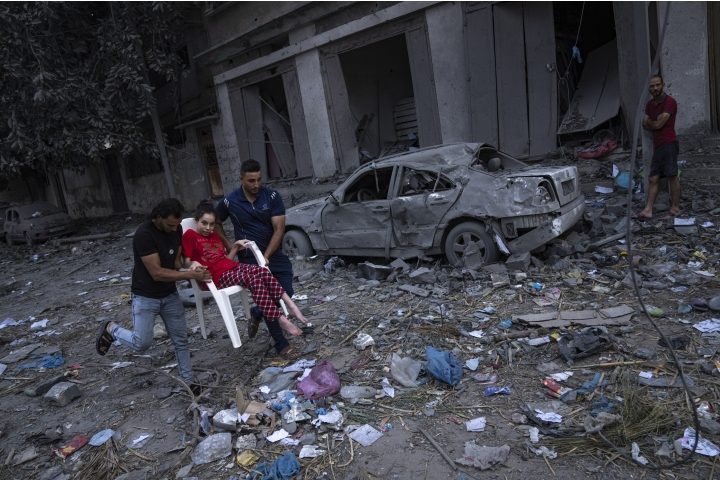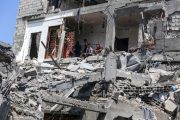
Thousands of people from the northern strip of Gaza fled south on Friday, October 13, after the Israeli military ordered a mass evacuation of parts of the densely populated coastal area that is home to over two million Palestinians.
“Civilians of Gaza City, evacuate south for your own safety and the safety of your families, and distance yourself from Hamas terrorists, who are using you as human shields,” the Israeli military ordered, slamming Hamas for hiding in and under civilian buildings.
As fears of an impending Israeli ground offensive mount, some Gaza residents said they worried that this could result in the beginning of another lasting mass displacement like the one in 1948, when over 700,000 Palestinians either escaped or were ousted from their homes in modern-day Israel.
“As I am packing my things I am wondering, is this really another nakba? I am taking my house key and thinking, will I ever return to my home, will I ever see my home again?” said Dr. Arwa El-Rayes, 56, before she departed from her childhood home in Gaza City in the north.
Nakba, which means “catastrophe,” is the term used by Palestinians for the displacement of 1948. Most of Gaza’s population and their descendants, around 1.7 million of the 2.1 million residents, were among those who were compelled to leave their homes in 1948. Despite being told that they would be permitted to return to their homes after a few days or weeks, many were never allowed to do so, taking with them only a few belongings and the keys to their front doors.
The Israeli military claimed that it was ordering for over one million residents of northern Gaza to evacuate to the southern half of the enclave for their own safety, even as residents insisted that Israeli airstrikes on the south persisted.
Palestinians in the southern and central areas of the enclave, where people were supposed to flee to, said air strikes had been conducted there overnight, with central parts also targeted on October 13.
“No place is safe in the entire Gaza Strip,” the Palestinian Red Crescent Society stated.
Israel pulverized the Gaza Strip on October 10 with the harshest air strikes in its 75-year conflict with the Palestinians, razing whole districts to rubble. On October 9, the Israeli army also summoned an unprecedented 300,000 reservists to help in its fight against Hamas.
Moreover, the Israeli military has been gathering tanks nearby prior to an anticipated ground offensive in retaliation for unexpected attack by Hamas on October 7 that so far has killed more than 1,300 people — including civilians and soldiers. Israel has claimed the horrific attack last weekend on its civilians meant it must eradicate the militant group.
Hamas tunnels, military compounds, senior operatives’ residences, as well as weapons storage warehouses were among 750 military targets attacked, Israeli authorities said.
Israeli airstrikes have killed more than 1,500 people in Gaza, according to the Gaza Health Ministry.
The Israeli military vowed to operate “significantly” in upcoming days, following Defense Minister Yoav Gallant’s declaration that “now is a time for war.”
“We are fighting for our home. We are fighting for our future,” Gallant said. “The path will be long, but ultimately I promise you we will win.”
Gazans said they were fearful of being compelled to go to remote areas with no services. Hamas, which controls the Gaza Strip, instructed residents to remain in spite of Israeli commands to the contrary, and pledged to fight till the end.
Some residents said they have opted to remain in their homes, despite the serious risks of an Israeli ground invasion, owing to worries about being permanently displaced.
“Death is better than leaving,” said Mohammad, 20, standing in the street outside a building reduced to ashes in an Israeli air strike two days ago. “I was born here, and I will die here. Leaving is a stigma.”
Other residents followed the instructions to evacuate, in spite of uncertainties about their future.
Gaza resident Mahmoud Shurrab said he read the orders to evacuate the northern part of the Gaza Strip on Facebook in the morning of October 13. Subsequently, he hastily packed a backpack with some important documents and began driving with his mother south in search of safety. At the moment, Shurrab and his mother are living on the streets without shelter.
“We are disoriented,” Shurrab said in a phone interview with The New York Times.
“We don’t know whether we will return or not. Nobody understands what’s going on. The biggest problem is that we have no idea where to stay,” he elaborated.
Some Gazans were seen evacuating either on foot or catching rides in trucks, as they did not have vehicles of their own.
Others maintained that the roads leading to the south were destroyed by almost a week of Israeli airstrikes and were difficult to navigate.
The UN has said that it was impossible to evacuate everyone, in wake of a cut in power supplies, faltering food and water supplies in Gaza, as well as a complete Israeli blockade of the enclave. Additionally, the globalist organization said Israel’s call for Gaza civilians to evacuate could not occur “without devastating humanitarian consequences.”
Its remarks prompted a riposte from Israel, which said the UN should denounce Hamas and back Israel’s efforts in self-defense.
Besides, the Red Cross has revealed that hospitals could soon run out of emergency fuel. International talks focused on providing aid and safe zones in Gaza, amid fears the conflict could spread.
Mahmoud Abbas, leader of the Palestinian Authority, a rival of Hamas, told U.S. Secretary of State Antony Blinken in Jordan that the forced displacement of Palestinians in Gaza would mean a repeat of 1948, urging for aid to be allowed into Gaza instantly.
Israel has announced it will not lift its blockade until hostages captured by Hamas are liberated.
Additionally, Tarik Jasarevic, a World Health Organization WHO spokesperson, has cautioned that Israel’s evacuation order was equivalent to a “death sentence” for severely ill and vulnerable hospital patients. Jasarevic contended that health authorities in Gaza have admitted that it was impossible to evacuate susceptible hospital patients within 24 hours based on Israeli military orders.
“There are severely ill people whose injuries mean their only chances of survival is being on life support, such as mechanical ventilators,” Jasarevic said.
“So moving those people is a death sentence. Asking health workers to do so is beyond cruel.”



